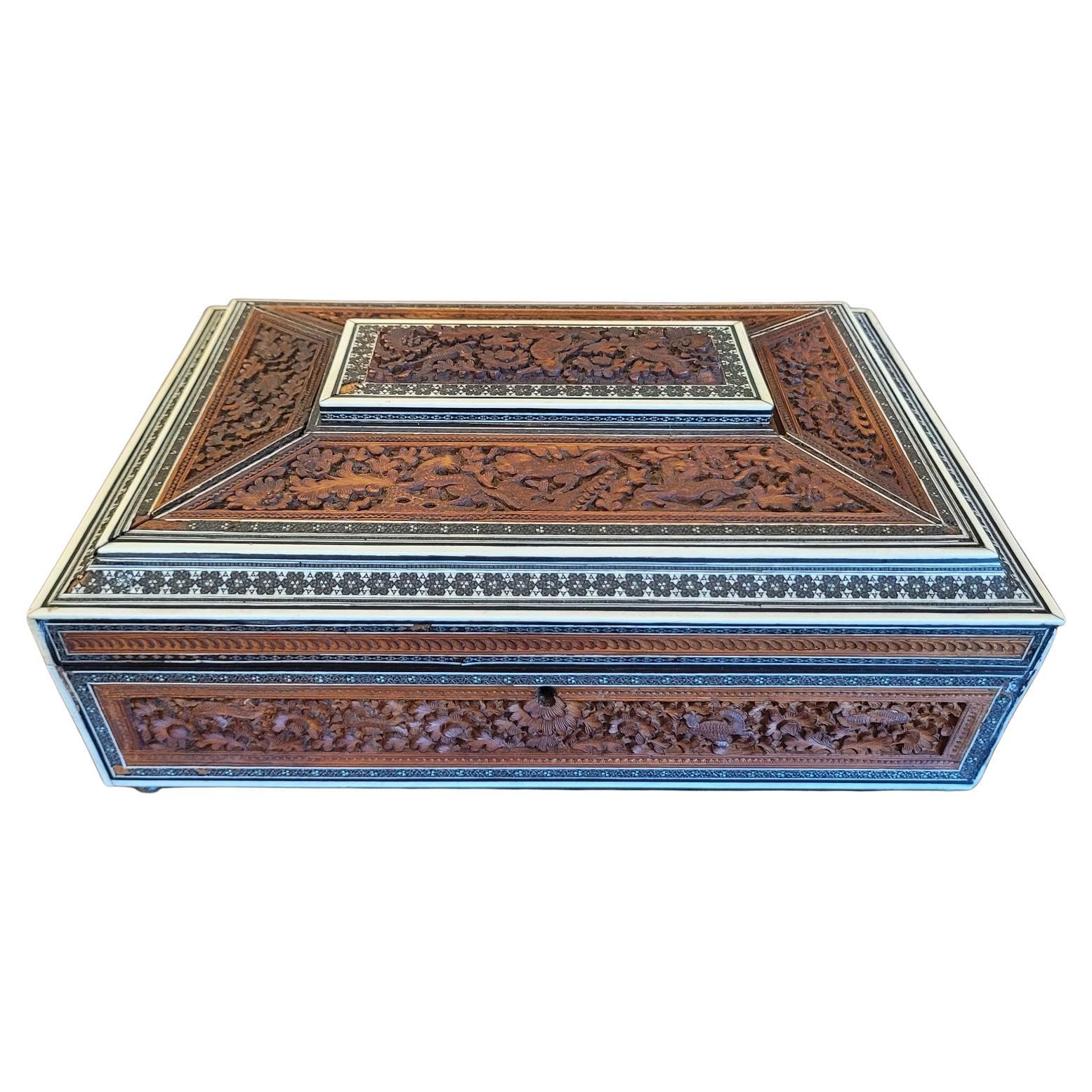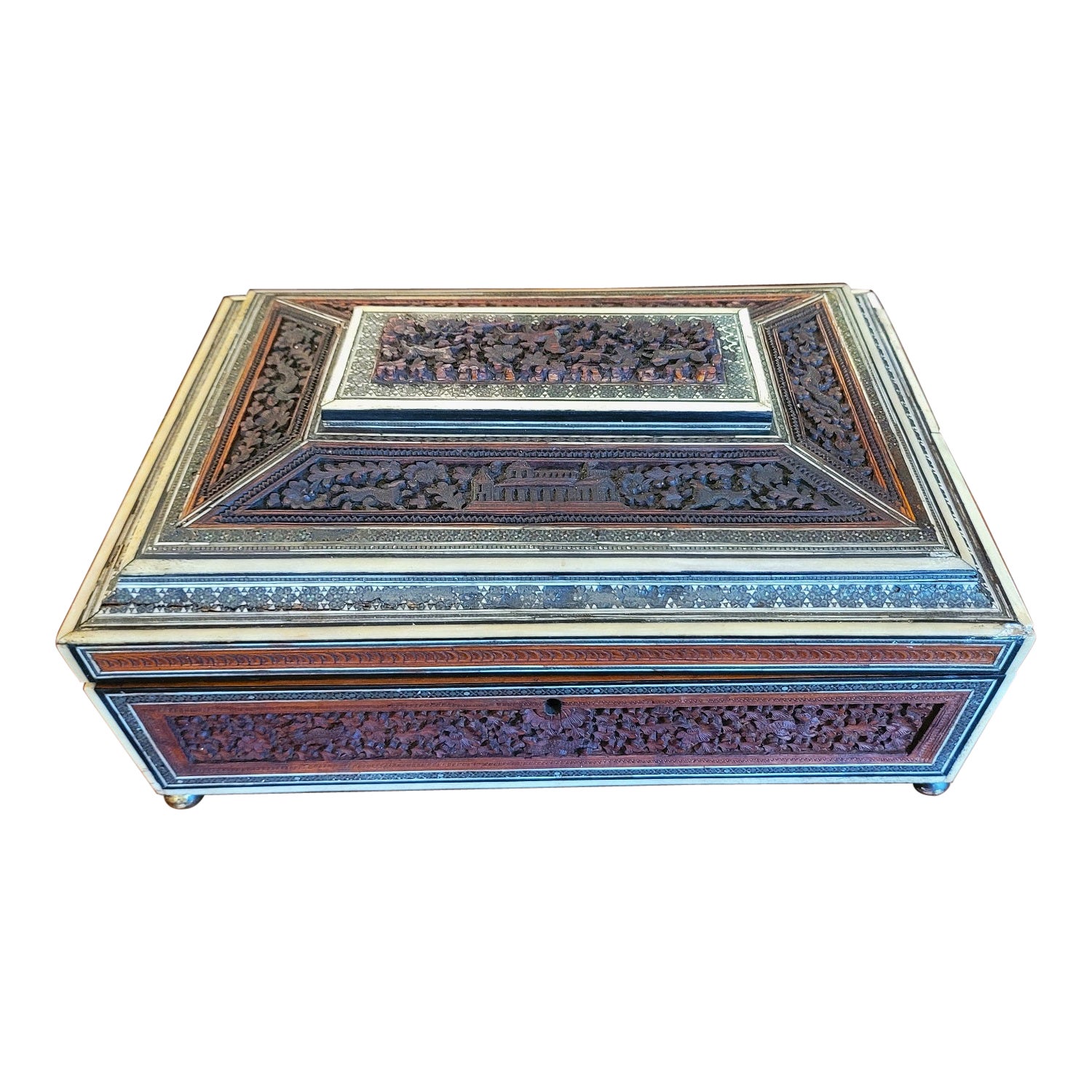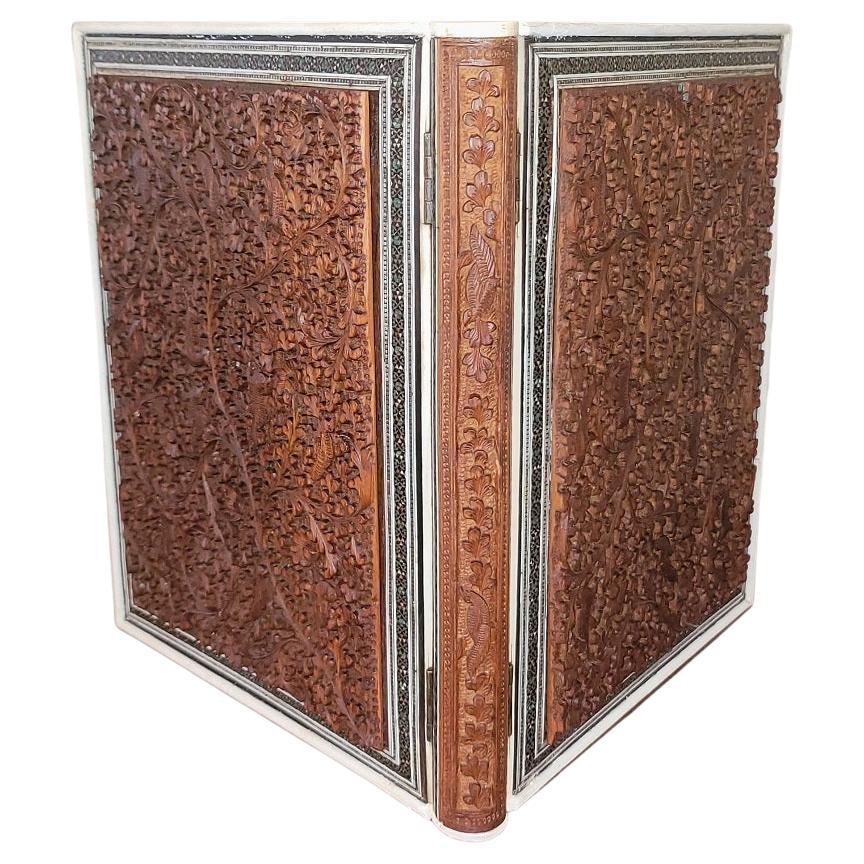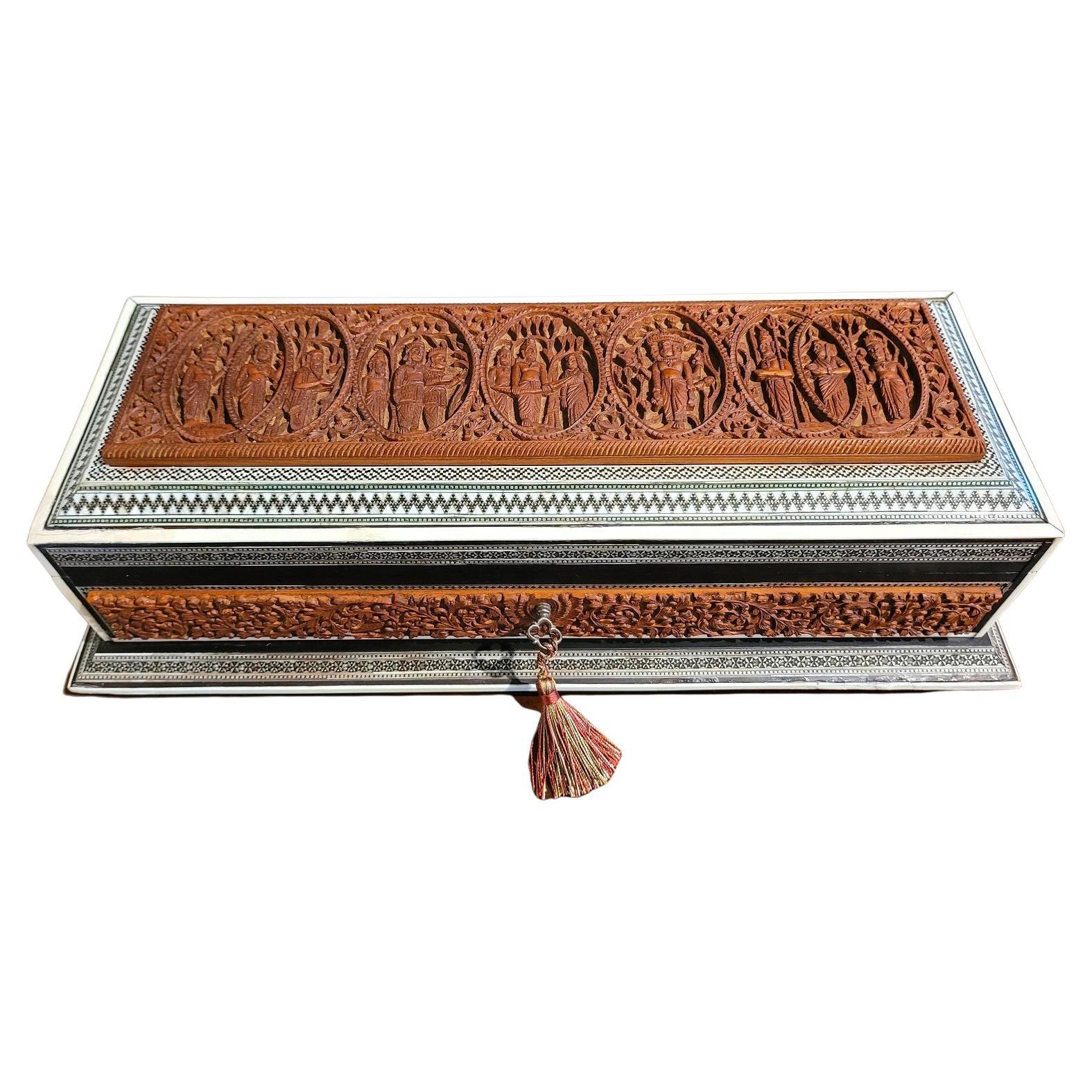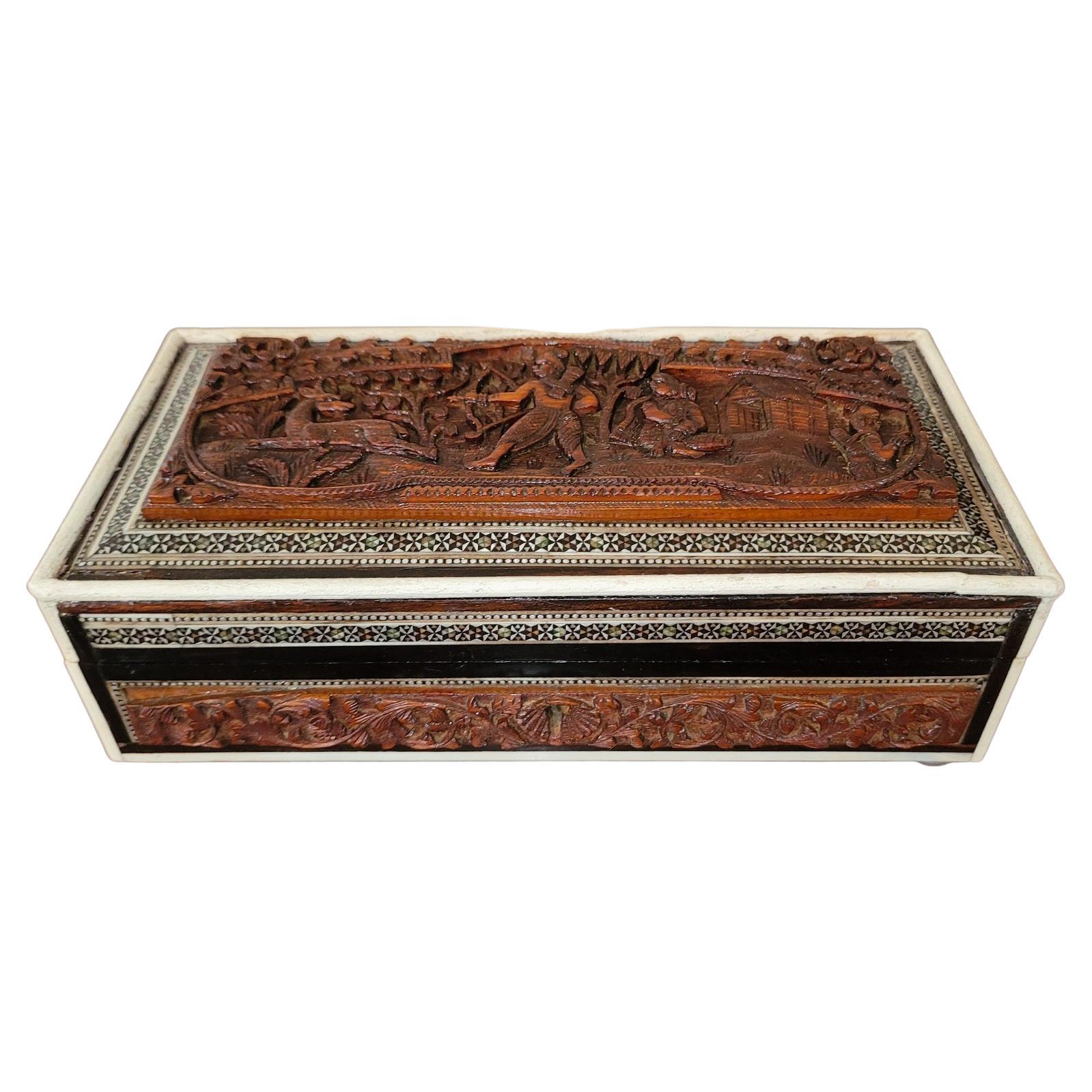Items Similar to 19c Anglo Indian Highly Carved Padouk and Sandalwood Sarcophagus Sewing Box
Want more images or videos?
Request additional images or videos from the seller
1 of 16
19c Anglo Indian Highly Carved Padouk and Sandalwood Sarcophagus Sewing Box
About the Item
PRESENTING A VERY NICE 19C Anglo Indian Highly Carved Padouk and Sandalwood Sarcophagus Sewing Box.
Made in Bombay, India circa 1890-1900.
The box case/body is made of sandalwood with highly carved padouk wood reliefs and panels on all sides. The panels on the top/lid are of elephants, tigers and birds of paradise with foliage. The carving on the sides is foliage only.
Edged with bone, ivorine and ebony.
The box is in a sarcophagus form with domed lid.
The original brass carry handles are on the sides.
This type of sewing box, from the Bombay area would normally have intricate ‘sadeli mosaic’ work all over, but this one did/does not. That is why we believe it to be later than other examples in our Inventory.
There is evidence of inlay work on the box exterior, but it was not Classic ‘sadeli’ work and appears to have consisted of hexagonal pewter medallions on the top/lid and pewter grains on the base inlay borders.
The box has been quite heavily restored, as it was in poor condition on the exterior. There were significant losses to the hexagonal pewter inlays and the areas of loss were filled and the entire border was ebonized. You can still see the hexagonal medallions under the ebonization. The bone edge moldings were replaced with ivorine.
The interior is in great condition and consists of a removeable mirror under the lid portion, with the original green baize lining behind it. The mirror has an ebonized border around the mirror glass which is bordered by bone molding.
The base is removeable and contains a number of lidded sandalwood compartments, edged with ebony.
The interior lids on the base, are each carved and chased.
It still has it’s original pin cushion insert, with blue velvet.
The box sits on 4 gold button feet (a later/recent addition).
Under the removeable tray, the original green baize is still there.
These boxes were made by superb Indian craftsmen, specifically for sale to the ruling British elite. These types of boxes, carved padouk and sandalwood, (whilst beautiful and superbly crafted) were of a lesser quality, than the more profusely and intricately mosaic inlay, tortoiseshell and ivory boxes, made for the British ‘Upper Classes’ in the areas of Bombay and Vizagapatam. These type of boxes were much more affordable back in 1880 (and indeed today) and would probably have been bought by mid-level diplomats, civil servants or visitors.
Sewing boxes (in general), were in EVERY Victorian home in Britain in the 19th century and like other boxes etc were ‘status symbols’ of your place in society! The more ornate the box, the more ‘Upper Class’ you were!
- Dimensions:Height: 4.5 in (11.43 cm)Width: 12.5 in (31.75 cm)Depth: 8.75 in (22.23 cm)
- Style:Anglo-Indian (Of the Period)
- Materials and Techniques:
- Place of Origin:
- Period:
- Date of Manufacture:1890-1900
- Condition:Repaired: Some repairs/ restorations that are detailed in the full posting (above). Refinished. Wear consistent with age and use. Minor losses. Minor structural damages. Minor fading. Some repairs/ restorations that are detailed in the full posting (above).
- Seller Location:Dallas, TX
- Reference Number:1stDibs: LU3978134776512
About the Seller
4.9
Platinum Seller
These expertly vetted sellers are 1stDibs' most experienced sellers and are rated highest by our customers.
Established in 2015
1stDibs seller since 2018
349 sales on 1stDibs
Typical response time: <1 hour
- ShippingRetrieving quote...Ships From: Dallas, TX
- Return PolicyA return for this item may be initiated within 7 days of delivery.
More From This SellerView All
- 19C Anglo Indian Highly Carved Padouk and Sandalwood Sadeli Mosaic Sarcophagus SLocated in Dallas, TXPRESENTING A GORGEOUS 19C Anglo Indian Highly Carved Padouk and Sandalwood Sadeli Mosaic Sarcophagus Sewing Box. Made in Bombay, India circa 1860-80. Box made of sandalwood with highly carved padouk wood reliefs and panels on all sides. Edged with bone and ebony veneers and glorious sadeli mosiac, made from tiny pieces of faux ivory, pewter, green semi-precious stone. The box is in a sarcophagus form with domed lid. The original brass carry handles are on the sides. The interior is in great condition and consists of a removeable mirror under the lid portion, with the original red velvet lining behind it. The base is removeable and contains a number of lidded compartments. 6 of the interior lids on the base, are each inlaid with sadeli mosaic banding. The rest are also carved and chased. The interior is fully complete with 7 lidded faux ivory/bone, thread canisters with sadeli domes and the original bone thimble. The box sits on 4 brass ball or bun feet with the original velvet lining on the base. Some minor repairs and losses, but this box is fully complete. This is ‘rare’ as many of these boxes have not survived in such condition! Included in the sale are 2 photos that were in the box (under the base tray). Interestingly, one of them is a view of downtown Nassau, New Providence (Bermuda) from the early 20C and stamped on the rear. What a ‘journey’ this piece has made! Made in India … travelled to Bermuda, probably via Britain … back to Ireland (where we bought it) …. then to Texas! These boxes were made by superb Indian craftsmen, specifically for sale to the ruling British elite. These types of boxes, carved padouk and sandalwood, (whilst beautiful and superbly crafted) were of a lesser quality, than the more profusely and intricately mosaic inlay, tortoiseshell and ivory boxes, made for the British ‘Upper Classes’ in the areas of Bombay and Vizagapatam. These type of boxes were much more affordable back in 1880 (and indeed today) and would probably have been bought by mid-level diplomats, civil servants or visitors. Sewing boxes (in general), were in EVERY Victorian home in Britain in the 19th Century and like other boxes etc were ‘status symbols’ of your place in society! The more ornate the box, the more ‘Upper Class’ you were! Of it’s type, this one, is one of the very higher quality one’s, than the norm! SADELI MOSAIC: “Anglo Indian boxes were made in India for the English residents from the early part of the 18th century. They were brought back or sent back to England usually by the people who had commissioned them. From the beginning of the nineteenth century they were imported more commercially, although not in any significant numbers until the middle decades. They were very highly valued, especially the early ones, to the extent that the designs were copied on late 19th and early 20th century tins. The ancient art of Sadeli Mosaic is said to have been introduced from Shiraz in Persia via Sind to Bombay, a long time before the Anglo Indian boxes were made. It was a technique, which required a high degree of skill and patience. It was executed very lavishly, in that the frequent cuts wasted a great amount of the precious materials used. The workmanship was however more than commensurable to the value of the materials. Ivory, silver, pewter (or other metals), wood and horn were cut into faceted rods which were bound together to form geometric patterns. When the glue has set, the rods were sliced in transverse sections. This gave the maker a number of angled circular pieces in the original pattern. Several variations of patterns could be achieved by combining the materials in different ways. The ivory was sometimes dyed green to give an extra color. The mosaic pieces in a combination of patterns, often separated by ivory, ebony, horn or silver stringing were used to veneer sandalwood boxes. In the early boxes, which date from the turn of the 18th to the 19th century, there are large panels of mosaic covering tops and sides of boxes. It took incredible skill to cover such large areas without any shakes or wavering of the pattern. The corners and joins on these boxes are impeccably matched. The makers (reputed to be Persian) of Sadeli mosaic made in the first two decades of the 19th century displayed a total understanding of the qualities of the different materials they used. They combined substances, which can expand and contract according to atmospheric conditions with others, which are hard and unyielding. The result was a sharp definition of the lines and patterns, which made up the whole design. On the early boxes the designs look deceptively simple. The fact is, they emerged from a culture, which had mastered geometry and understood how to generate a pattern from a set number of points. The patterns are so harmoniously combined that their incredible complexity is not immediately apparent. The earliest Sadeli boxes...Category
Antique 19th Century Indian Anglo-Indian Decorative Boxes
MaterialsBone, Padouk, Sandalwood
- 19C Anglo Indian Highly Carved Padouk Wood with Sadeli Mosaic Inlay Sewing BoxLocated in Dallas, TXPRESENTING A LOVELY 19C Anglo Indian Highly Carved Padouk Wood with Sadeli Mosaic Inlay Sewing Box. Made in Bombay, India, circa 1880. The box is made of sandalwood with highly carved raised padouk wood panels on all sides, depicting temple scenes, animals and foliage. The box is in a sarcophagus form. It is edged in bone (and we can tell it is bone and not ivory, from the color and evidence of capillaries, which are not found in ivory), and banded with Bombay Sadeli mosaic and ebony veneer. The lid opens to reveal a removable tray with various open compartments and lidded compartments. 5 lidded compartments, 1 unlidded compartment and 8 holders for thimbles, etc The tray lifts to reveal a blue velvet (original) lined section, for storing jewelry etc, with sections for collars etc. The inside of the lid has a removable mirror (the mirror is missing on this one but can easily be replaced). Behind the mirror is the original green velvet lining. It has its original brass carry handles on the sides and sits on 4 silvered button feet (of recent origin). Some repairs to the exterior and condition issues (priced accordingly), but still a LOVELY COLLECTIBLE box! These boxes were made by superb Indian craftsmen, specifically for sale to the ruling British elite. These types of boxes, carved padouk and sandalwood, (whilst beautiful and superbly crafted) were of a lesser quality, than the more profusely and intricately mosaic inlay, tortoiseshell and ivory boxes, made for the British ‘Upper Classes’ in the areas of Bombay and Vizagapatam. These type of boxes were much more affordable back in 1880 (and indeed today) and would probably have been bought by mid-level diplomats, civil servants or visitors. Sewing boxes (in general), were in EVERY Victorian home in Britain in the 19th century and like other boxes etc were ‘status symbols’ of your place in society! The more ornate the box, the more ‘Upper Class’ you were! SADELI MOSAIC: “Anglo Indian boxes were made in India for the English residents from the early part of the 18th century. They were brought back or sent back to England usually by the people who had commissioned them. From the beginning of the nineteenth century they were imported more commercially, although not in any significant numbers until the middle decades. They were very highly valued, especially the early ones, to the extent that the designs were copied on late 19th and early 20th century tins. The ancient art of Sadeli Mosaic is said to have been introduced from Shiraz in Persia via Sind to Bombay, a long time before the Anglo Indian boxes were made. It was a technique, which required a high degree of skill and patience. It was executed very lavishly, in that the frequent cuts wasted a great amount of the precious materials used. The workmanship was however more than commensurable to the value of the materials. Ivory, silver, pewter (or other metals), wood and Horn were cut into faceted rods which were bound together to form geometric patterns. When the glue has set, the rods were sliced in transverse sections. This gave the maker a number of angled circular pieces in the original pattern. Several variations of patterns could be achieved by combining the materials in different ways. The ivory was sometimes dyed green to give an extra color. The mosaic pieces in a combination of patterns, often separated by ivory, ebony, Horn or silver stringing were used to veneer sandalwood boxes. In the early boxes, which date from the turn of the 18th to the 19th century, there are large panels of mosaic covering tops and sides of boxes. It took incredible skill to cover such large areas without any shakes or wavering of the pattern. The corners and joins on these boxes are impeccably matched. The makers (reputed to be Persian) of Sadeli mosaic made in the first two decades of the 19th century displayed a total understanding of the qualities of the different materials they used. They combined substances, which can expand and contract according to atmospheric conditions with others, which are hard and unyielding. The result was a sharp definition of the lines and patterns, which made up the whole design. On the early boxes the designs look deceptively simple. The fact is, they emerged from a culture, which had mastered geometry and understood how to generate a pattern from a set number of points. The patterns are so harmoniously combined that their incredible complexity is not immediately apparent. The earliest Sadeli boxes...Category
Antique Late 19th Century Indian Anglo-Indian Decorative Boxes
MaterialsBone, Padouk, Sandalwood
- 19C Anglo Indian Highly Carved Padouk and Mosaic Folio CoverLocated in Dallas, TXPRESENTING A RARE AND DESIRABLE 19C Anglo Indian Highly Carved Padouk and Mosaic Folio Cover. This is a VERY RARE piece of Anglo-Indian and British Victorian Colonial history! ...Category
Antique Late 19th Century Indian Anglo Raj Decorative Boxes
MaterialsBone, Precious Stone, Sandalwood
- 19C Anglo Indian Highly Carved Padouk Sadeli Mosaic Scroll Box of Hindu GodsLocated in Dallas, TXPRESENTING AN ABSOLUTELY STUNNING AND EXCEPTIONAL 19C Anglo Indian Highly Carved Padouk Sadeli Mosaic Scroll Box of Hindu Gods from circa 1870-80. The box case is made from sandalwood with highly hand-carved padouk wood reliefs on all sides and banded and edged in fabulous ‘Sadeli Mosaic’, made from faux ivory/bone, ebony, silver, semi-precious green stone, etc., in various geometric patterns. The carved lid of this box is EXCEPTIONAL! It is HIGHLY HAND-CARVED and depicts 13 Hindu Gods: Vishnu, Shiva, Harihara, etc., in 9 oval shaped reliefs, surrounded by foliage etc. The sides and rear have highly carved foliage relief panels. The lid opens to reveal the original red velvet lining (also on the base) in SUPERB CONDITION throughout. The QUALITY of the ‘sadeli mosaic’ work is EXCEPTIONAL all over. It has its key and working lock. It sits on it’s 4 original brass turned ball feet. THIS IS A HIGH QUALITY & VERY RARE AND DESIRABLE BOX! SADELI MOSAIC: “Anglo Indian boxes were made in India for the English residents from the early part of the 18th century. They were brought back or sent back to England usually by the people who had commissioned them. From the beginning of the nineteenth century they were imported more commercially, although not in any significant numbers until the middle decades. They were very highly valued, especially the early ones, to the extent that the designs were copied on late 19th and early 20th century tins. The ancient art of Sadeli Mosaic is said to have been introduced from Shiraz in Persia via Sind to Bombay, a long time before the Anglo Indian boxes were made. It was a technique, which required a high degree of skill and patience. It was executed very lavishly, in that the frequent cuts wasted a great amount of the precious materials used. The workmanship was however more than commensurable to the value of the materials. Ivory, silver, pewter (or other metals), wood and horn were cut into faceted rods which were bound together to form geometric patterns. When the glue has set, the rods were sliced in transverse sections. This gave the maker a number of angled circular pieces in the original pattern. Several variations of patterns could be achieved by combining the materials in different ways. The ivory was sometimes dyed green to give an extra color. The mosaic pieces in a combination of patterns, often separated by ivory, ebony, horn or silver stringing were used to veneer sandalwood boxes. In the early boxes, which date from the turn of the 18th to the 19th century, there are large panels of mosaic covering tops and sides of boxes. It took incredible skill to cover such large areas without any shakes or wavering of the pattern. The corners and joins on these boxes are impeccably matched. The makers (reputed to be Persian) of Sadeli mosaic made in the first two decades of the 19th century displayed a total understanding of the qualities of the different materials they used. They combined substances, which can expand and contract according to atmospheric conditions with others, which are hard and unyielding. The result was a sharp definition of the lines and patterns, which made up the whole design. On the early boxes the designs look deceptively simple. The fact is, they emerged from a culture, which had mastered geometry and understood how to generate a pattern from a set number of points. The patterns are so harmoniously combined that their incredible complexity is not immediately apparent. The earliest Sadeli boxes...Category
Antique 19th Century Indian Anglo-Indian Decorative Boxes
MaterialsSilver
- 19C Anglo Indian Carved Padouk Wood and Sadeli Mosaic BoxLocated in Dallas, TXPRESENTING A LOVELY 19th century Anglo-Indian Carved Padouk Wood and Sadeli Mosaic Box, featuring a carving of a Hunt Scene. Made circa 1870 in Bombay, India during the Rule of th...Category
Antique Late 19th Century Indian Anglo-Indian Jewelry Boxes
MaterialsSilver, Pewter
- 19C Anglo Indian Vizigapatam Stamp BoxLocated in Dallas, TXPresenting an absolutely gorgeous and very rare 19C Anglo Indian Vizigapatam stamp box. Made in Colonial India (the Time of the Raj) circa 1860. Prob...Category
Antique Mid-19th Century Indian Anglo-Indian Decorative Boxes
MaterialsBone, Shell
You May Also Like
- Regency Anglo Indian Quill Work Vizagapatam Sandalwood Sewing BoxLocated in New York, NYThis fine Regency period quill work, bone, ivory & sandalwood sewing box with intact interior w sewing implements.Category
Antique Early 19th Century Indian Regency Decorative Boxes
MaterialsBone, Ivory, Sandalwood
- Anglo-Indian Padouk BoxLocated in London, GBAn Anglo-Indian brass-mounted padouk and ebony box, Ceylon, second half of the 18th century.Category
Antique 18th Century Decorative Boxes
MaterialsBrass
- 19th Century Anglo Indian Vizagapatam Carved Sandalwood Box Micro Mosaic InlaysLocated in GBWe are delighted to offer for sale this lovely 19th century Anglo-Indian Vizagapatam carved sandalwood and inlaid box Mid-19th century Anglo-Indian Vizagapatam carved sandalwood box...Category
Antique 19th Century Indian Anglo-Indian Decorative Boxes
MaterialsWood
- Anglo-Indian Ribbed Horn Box with Sandalwood InteriorLocated in Chapel Hill, NCAnglo-Indian glove or trinket box from Vizagapatam of rectangular form with sloped top. Made from sandalwood with vertically ribbed horn veneered sides and starburst ribbed lid with ...Category
Antique Mid-19th Century Indian Anglo Raj Decorative Boxes
MaterialsHorn, Wood
- Anglo-Indian 14"w Stag Horn Veneered Sandalwood Document/Storage BoxLocated in Chapel Hill, NCAnglo-Indian antler veneered work/storage made in Vizagapatam, of large size and having a double tiered sloped top with a large circular finial above vertically veneered sides, all r...Category
Antique Mid-19th Century Indian Anglo Raj Decorative Boxes
MaterialsAntler, Horn, Wood
- 19th Century Anglo-Indian Vizagapatam Antler Veneered Sewing / Work BoxLocated in Chapel Hill, NCA fine Vizagapatam made antler veneered sewing / work box having tapered sides and a double tiered four-slope lid with a carved finial and all raised on four turned feet. The interio...Category
Antique Mid-19th Century Indian Anglo-Indian Decorative Boxes
MaterialsAntler, Wood
Recently Viewed
View AllMore Ways To Browse
Hand Carved Indian Wood Tray
Bombay Mirror
Hexagon Brass Tray
Ebonized Cushion Mirror
Ebony Wood Elephant
Bone Inlay Elephant
Crystal Glove Box
Cut Throat Razors
Dazey Butter Churn
Elk Horn Box
Elk Horn Boxes
Fred And Marilyn Buss
Fred Marilyn Buss
John Nicholas Otar
Leatherbound Liquor
Lighter Colibri Vintage
Matara Box
Otar Art Deco Cigarette Box
